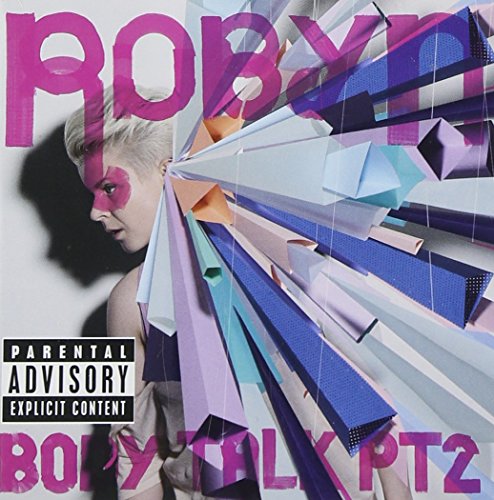
Robyn
Body Talk, Pt. 2
Release Date: Sep 7, 2010
Genre(s): Pop, Electronic, R&B, Urban, Pop/Rock, Alternative/Indie Rock, Dance-Pop, Euro-Pop, Club/Dance, Alternative Dance, Euro-Dance
Record label: Island
Music Critic Score
How the Music Critic Score works
Buy Body Talk, Pt. 2 from Amazon
Album Review: Body Talk, Pt. 2 by Robyn
Great, Based on 11 Critics
Based on rating A
”Don’t fall recklessly, headlessly in love with me,” Robyn warns in ”Hang with Me.” Oops, too late: On Body Talk Pt. 2, this eight-track follow-up to June’s Body Talk Pt. 1, the Swedish electro-pop pixie uses sleek club music to endearingly explore more unpolished emotions, such as anxiety (”In My Eyes”) and heartbreak (”Love Kills”).
Based on rating 8/10
Swedish-born singer Robin Miriam Carisson, better known as Robyn, has a proven track record of making effortless, forward-thinking, and sophisticated pop music. She's never made a bad album and since her 1995 debut Robyn has consistently kept critics and listeners on the edge of their seats always wanting more. Ten years into her recording career she released the self-titled Robyn, which was—by all accounts—as flawless a pop record as has ever been recorded.
Based on rating 8.0/10
The people making the best pop music in the world are typically also among the world's biggest pop stars. Alas, Robyn is not even close to upper-tier status, despite being responsible for some of the most indelible dance-pop of the past half-decade. "Be Mine!", "With Every Heartbeat", "Dancing on My Own"-- in a perfect world these are all global smash hits.
Based on rating 4/5
Hang With Me, Robyn's new single and the centrepiece of this second of three Body Talk albums she plans to release this year, is about the boundaries between friendship and love. So are a lot of pop singles, of course, usually sitting bitterly on the "friendship" side and sniping over the border. But Robyn takes "just friends" more seriously, and her song is a checklist of what that phrase might mean, with a tender but firm warning not to fall "headlessly" in love with her, whatever else happens.
Based on rating 4/5
The second of three albums Swedish pop star Robyn plans to release this year, Body Talk Pt. 2 is another concise, eight-song collection that clocks more time on the dance floor than its predecessor. On the first three tracks, she tackles enduring pop-music themes like love, loneliness and friendship with the kind of unsentimental yet empathetic songwriting fans of the Pet Shop Boys might admire.
Based on rating 7.5/10
Last month Robyn played in New York City, and one person who was in the audience said she was surrounded by tons of well-dressed-but-becoming-undressed dudes in the crowd, groping each other while the Swede commiserated about urban heartbreak and not wanting to be alone in the club. She said the exhilaration of the pure dance experience got her right into the music, well worth the exhausting post-concert train ride home. Conversely, I read a blog post the next day from another concertgoer complaining about how sweaty and crowded the place had been, making it impossible to enjoy the music.
Based on rating 7/10
Robyn's appeal is not difficult to pin down. Since her re-emergence from the Nineties Europop assembly line with her eponymous re-debut (2005's Robyn), she's pretty much served as the poster child for late-Noughties 'post-pop' - as the commercial music machine continues to crumble, artists with pop sensibilities are taking the genre and creating creative, singular works with artistic intent, freed from the financial censorship they would have once been subject to. And Robyn is the undisputed queen of this movement; a blonde, Swedish Grace Jones towering over every other would-be independent pop star, combining a fearless willingness to express herself with unparalleled sensibilities honed by a half a life of collaboration with the Swedish pop royalty of the bad old days.
Based on rating 3.5/5
Almost every track on Robyn’s Body Talk Pt. 1 sounded like a smash single; in fact, most of them were released promotionally in one form or another. On the contrary, the second installment in the trilogy feels like it’s filled with album tracks—albeit album tracks from a pretty fucking fantastic album. “We Dance to the Beat” is sick, a sister song to the even more irreverent “Don’t Fucking Tell Me What to Do,” and “Love Kills” would be a highlight even on Pt.
Based on rating 6/10
When Robyn appeared back in 1997 (crikey!), nobody was surprised when that heartless fiend we call “The Dumper” beckoned and consigned another soul to the ghostly netherworld of the bargain bin. Mixing Europop and R&B? This does not compute. A “lay-dee” telling record company bean counters how to sell records? Preposterous! This feisty Swede yelled “Non!” to flowing locks ‘n’ Cinderella frocks and “Oui!” to Mozzer-high quiffs ‘n’ Doc Martens.
Based on rating 6/10
Let me start off by saying that I fell head over heels for Robyn in March of this year, when I purchased 2005’s Robyn on a whim after hearing the that she was going to release three(!) full length albums in 2010. Anyone who knows Robyn’s work can understand the sentiment: She’s simply everything. Her 2005 album featured a mélange of musical styles, ranging from club-ready hip-hop, propulsive electro-pop, and even a bit of bubble gum (the latter most likely being related to her previous 90s incarnation as a R&B-inflected songstress).
Opinion: Fantastic
The Swede is the best, most versatile pop star currently at work. Jaime Gill 2010 That five years passed between Robyn’s last album and 2010’s Body Talk trilogy shouldn’t surprise anyone: Robin Carlsson’s career has always been wayward. By 18 she'd scored a Max Martin-produced international smash hit (accidentally inventing Britney Spears as a by-product), before a period of artistic experimentation which alienated her major label bosses.
'Body Talk, Pt. 2'
is available now

